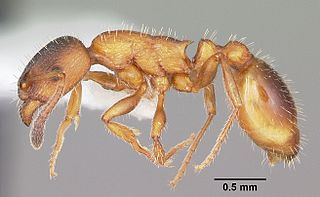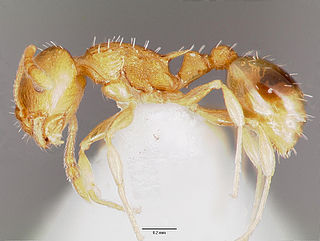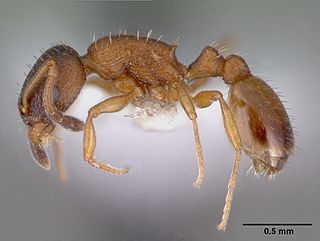
Van and Schenck were popular United States entertainers in the 1910s and 1920s: Gus Van, baritone, and Joe Schenck (pronounced "skenk"; born Joseph Thuma Schenck,, tenor. They were vaudeville stars and made appearances in the Ziegfeld Follies of 1918, 1919, 1920 and 1921. They made numerous phonograph records for the Emerson, Victor, and Columbia record companies.

Joseph Michael Schenck was a Russian-born American film studio executive.

Myrmicinae is a subfamily of ants, with about 140 extant genera; their distribution is cosmopolitan. The pupae lack cocoons. Some species retain a functional sting. The petioles of Myrmicinae consist of two nodes. The nests are permanent and in soil, rotting wood, under stones, or in trees.

Cardiocondyla is an Old World genus of ants in the subfamily Myrmicinae.

Leptothorax recedens is a species of ant in the family Formicidae. It is found in France, Italy, and Spain, with the most recent finding in Slovenia.

Crematogastrini is a tribe of myrmicine ants with 64 genera and 8 fossil genera.

Leptothorax acervorum is a small brown to yellow ant in the subfamily Myrmicinae. It was first described by Johan Christian Fabricius in 1793. L. acervorum is vastly distributed across the globe, most commonly found in the coniferous forests of Central, Western and Northern Europe. The morphology of L. acervorum is extremely similar to that of other Leptothorax ants. The difference arises in the two-toned appearance of L. acervorum, with the head and metasoma being darker than the mesosoma segment of the body, and hair across its body. Following Bergmann's rule—unusually, for ectothermic animals—body size increases with latitude.

Temnothorax is a genus of ants in the subfamily Myrmicinae. It contains more than 380 species.

Pseudolasius is a genus of ants in the subfamily Formicinae. The genus is known from southern Asia to northern Australia, where it appears to be restricted to tropical areas.

Slave-making ants are brood parasites that capture broods of other ant species to increase the worker force of their colony. After emerging in the slave-maker nest, slave workers work as if they were in their own colony, while parasite workers only concentrate on replenishing the labor force from neighboring host nests, a process called slave raiding.

Temnothorax nylanderi is a species of ant in the genus Temnothorax. The species is found in western Europe. It was first described by Förster (1850) based on a male from Germany.

Temnothorax curvispinosus is a species of ant in the genus Temnothorax. The species is common and widely distributed in eastern United States, where they inhabit forested areas. They build their nests in plant cavities, in the soil or under rocks.

Temnothorax rugatulus is a species of ant in the genus Temnothorax. It is found in North America. More specifically, it is found in the forests of the western United States. Colonies are either monogynous or polygynous. Queens in monogynous colonies are generally larger (marcogynes), about twice the size of conspecific workers; polygynous colonies have smaller queens (microgynes), typically slightly smaller than the workers. T. rugatulus ants are a subdominant ant group.

Leptothorax muscorum is a species of ant of the genus Leptothorax that ranges through a variety of habitats throughout much of Europe, northern Asia, and North and Central America, with a particularly wide distribution in the palearctic. Capable of surviving in extreme Arctic-Alpine conditions, the species is perhaps the northernmost dwelling ant indigenous to the Western Hemisphere.
Anomotaenia brevis is a tapeworm which has been found to be one of many parasite species able to manipulate their host's behavior. Host manipulation is commonly observed in parasites with complex life cycles reliant on multiple hosts for development. While the definitive host for A. brevis is the woodpecker, their intermediate host is the Temnothoraxnylanderi, a species of ant located in the oak forests of western Europe. The tapeworm alters the appearance and behavior of the T. nylanderi ant in order to ensure transmission to the woodpecker, where it can complete its life cycle.

Temnothorax tuberum is a species of ant belonging to the family Formicidae.
Temnothorax corticalis is a species of ant belonging to the family Formicidae.

Leptothorax longispinosus is an American species of ant.
















